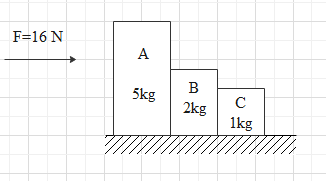
The given figure shows three blocks in contact and kept on a smooth horizontal surface. What is the ratio of force exerted by block A on B to that of B on C?

A.$3:1$
B. $1:3$
C. $2:3$
D. $3:2$
Answer
217.8k+ views
Hint: Look at this problem considering different systems, first consider all three blocks as a system, check the external forces and then apply Newton’s Second law, then follow the same for all three individual blocks or the two blocks from which you will obtain the required forces.
Complete step by step answer:
From the figure we can see
the mass of the block A, ${m_A} = 5\,kg$
mass of the block B, ${m_B} = 2\,kg$
mass of the block C, ${m_C} = 1\,kg$
Therefore, total mass of three blocks,
$M = {m_A} + {m_B} + {m_C}$
$ \Rightarrow M = 5\,kg + 2\,kg + 1\,kg$
$\therefore M = 8\,kg$
According to Newton 2nd law force is the rate of change of momentum. That is,
$F = \dfrac{{dP}}{{dt}}$
Where $P$ is a momentum given by
$P = mv$
Substituting this in equation 1 we get
$F = m\dfrac{{dv}}{{dt}}$
So, Newton's second law can also be expressed as
$F = ma$
Where, $m$ is the mass and $a$ is the acceleration.
From this acceleration is equal to
$a = \dfrac{F}{M}$
On substituting the given values, we get
Acceleration of the block
$a = \,\dfrac{{16}}{8}\, = 2\,m/{s^2}$
Let ${F_{AB}}$ be the force of contact exerted by block A on B and let ${F_{BC}}$ be the force exerted by block B on C
So, we can write the net force on A as the force given on A minus contact force exerted by block A on B.
${m_A}a = F - {F_{AB}}$
That is,
$5 \times 2 = 16 - {F_{AB}}$
$ \Rightarrow {F_{AB}} = 6\,N$
Now, we can write the force on B as force on B due to A minus the force on C due to B.
${m_B}a = {F_{AB}} - {F_{CB}}$
That is,
$2 \times 2 = 6 - {F_{BC}}$
$ \Rightarrow {F_{BC}} = 2\,N$
Therefore,
The ratio of force exerted by block A on B to that of B on C is
$\dfrac{{{F_{AB}}}}{{{F_{BC}}}} = \dfrac{6}{2}$
$\therefore \dfrac{{{F_{AB}}}}{{{F_{BC}}}} = \dfrac{3}{1}$
So, the ratio of the two forces is 3:1 .
Thus, the answer is option A.
Note: The acceleration of the three blocks will be the same but net force on each block will be different due to the difference in mass of the blocks.
The contact force exerted by A on B is same as that of B on A. That is
${F_{AB}} = {F_{BA}}$
Also,
${F_{BC}} = {F_{CA}}$
Complete step by step answer:
From the figure we can see
the mass of the block A, ${m_A} = 5\,kg$
mass of the block B, ${m_B} = 2\,kg$
mass of the block C, ${m_C} = 1\,kg$
Therefore, total mass of three blocks,
$M = {m_A} + {m_B} + {m_C}$
$ \Rightarrow M = 5\,kg + 2\,kg + 1\,kg$
$\therefore M = 8\,kg$
According to Newton 2nd law force is the rate of change of momentum. That is,
$F = \dfrac{{dP}}{{dt}}$
Where $P$ is a momentum given by
$P = mv$
Substituting this in equation 1 we get
$F = m\dfrac{{dv}}{{dt}}$
So, Newton's second law can also be expressed as
$F = ma$
Where, $m$ is the mass and $a$ is the acceleration.
From this acceleration is equal to
$a = \dfrac{F}{M}$
On substituting the given values, we get
Acceleration of the block
$a = \,\dfrac{{16}}{8}\, = 2\,m/{s^2}$
Let ${F_{AB}}$ be the force of contact exerted by block A on B and let ${F_{BC}}$ be the force exerted by block B on C
So, we can write the net force on A as the force given on A minus contact force exerted by block A on B.
${m_A}a = F - {F_{AB}}$
That is,
$5 \times 2 = 16 - {F_{AB}}$
$ \Rightarrow {F_{AB}} = 6\,N$
Now, we can write the force on B as force on B due to A minus the force on C due to B.
${m_B}a = {F_{AB}} - {F_{CB}}$
That is,
$2 \times 2 = 6 - {F_{BC}}$
$ \Rightarrow {F_{BC}} = 2\,N$
Therefore,
The ratio of force exerted by block A on B to that of B on C is
$\dfrac{{{F_{AB}}}}{{{F_{BC}}}} = \dfrac{6}{2}$
$\therefore \dfrac{{{F_{AB}}}}{{{F_{BC}}}} = \dfrac{3}{1}$
So, the ratio of the two forces is 3:1 .
Thus, the answer is option A.
Note: The acceleration of the three blocks will be the same but net force on each block will be different due to the difference in mass of the blocks.
The contact force exerted by A on B is same as that of B on A. That is
${F_{AB}} = {F_{BA}}$
Also,
${F_{BC}} = {F_{CA}}$
Recently Updated Pages
Arithmetic, Geometric & Harmonic Progressions Explained

Cartesian Form of Vector Explained: Formula, Examples & Uses

Apparent Frequency Explained: Formula, Uses & Examples

Calorimetry: Definition, Principles & Calculations

Centrifugal Force Explained: Definition, Formula & Examples

Charge in a Magnetic Field: Definition, Formula & Examples

Trending doubts
JEE Main 2026: Application Form Open, Exam Dates, Syllabus, Eligibility & Question Papers

Derivation of Equation of Trajectory Explained for Students

Hybridisation in Chemistry – Concept, Types & Applications

Understanding the Angle of Deviation in a Prism

Understanding Collisions: Types and Examples for Students

How to Convert a Galvanometer into an Ammeter or Voltmeter

Other Pages
JEE Advanced Marks vs Ranks 2025: Understanding Category-wise Qualifying Marks and Previous Year Cut-offs

Units And Measurements Class 11 Physics Chapter 1 CBSE Notes - 2025-26

NCERT Solutions For Class 11 Physics Chapter 8 Mechanical Properties Of Solids

Motion in a Straight Line Class 11 Physics Chapter 2 CBSE Notes - 2025-26

NCERT Solutions for Class 11 Physics Chapter 7 Gravitation 2025-26

Understanding Atomic Structure for Beginners




